Engineering Open House 2018 Encourages Visitors to Consider Engineering’s Impact Both Today and Tomorrow
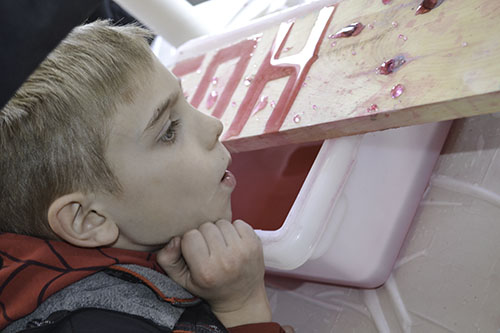 At EOH 18, a local 1st grader learns about the effect of hydrophobic materials as he blows on water, causing it to bead up on a treated board.
At EOH 18, a local 1st grader learns about the effect of hydrophobic materials as he blows on water, causing it to bead up on a treated board.March 15, 2018
On March 9–10, 2018, thousands of visitors flooded the University of Illinois campus to participate in EOH 2018: Drafting the Future. School classes made field trips; parents played hookey from work to bring their kids; high school students considering Engineering at Illinois made the trek from near and far. And there to meet them were hundreds of proud Engineering students, eager to show off what they’ve been learning or researching.
EOH 2018 featured more than 250 exhibits, including many hands-on activities, demonstrations, contests, races, and other displays. Most of the engineering disciplines on campus were represented.
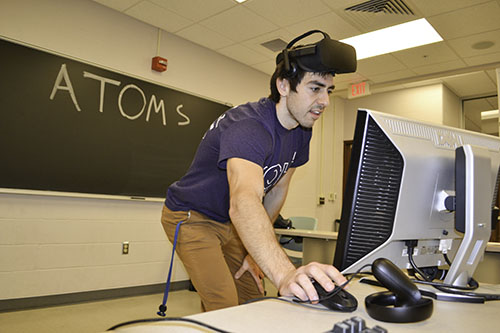
Kyle Mackay, MechSE Ph.D. student, sets up a virtual reality experience about atoms in motion for EOH visitors to try.
For instance, Aerospace students/organizations showcased their discipline via a variety of exhibits, including several exciting rocket launches or rocket races. Physics students and members of physics societies or organizations, such as the Physics Van, did fun exhibits or demos about physics. Exposing visitors to distillation, one of Chemical Engineering’s fundamental separation techniques, were members of OXE (Omega Chi Epsilon), while members of AIChE (American Institute of Chemical Engineers) exposed visitors to electrochemistry.
Many students at EOH were representing their labs and showcasing the research that goes on there, such as Kyle Mackay, a MechSE Ph.D. student who studies surface chemistry and plasma-assisted combustion.
Mackay was on hand to expose visitors to Atoms in Motion: A Virtual Reality Experience. He reports that in his research, he simulates atomic motions and atomic interactions on surfaces, looking at how chemistry at surfaces affects flames and plasma when they interact with the surface. So he volunteered for EOH in order to share with visitors some of the fun things he gets to experience every day.
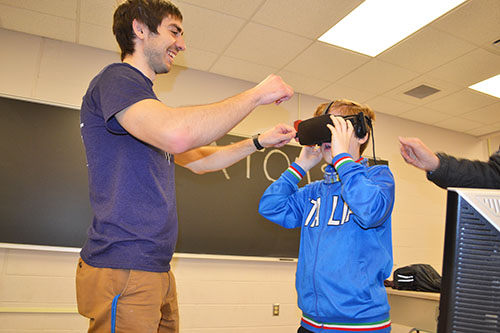
MechSE Ph.D. student Kyle Mackay helps adjust the VR equipment on his first young visitor: 10-year-old William Johnson.
“I really enjoy molecular dynamic simulations where you can see atoms moving around and stuff.”
Mackay has evidently been thinking about doing a VR presentation related to is work for a while now. “I always thought that it would be really cool to be able to step into that and actually see the atoms moving around you,” he admits.
He goes on to explain that his work with molecular dynamic simulations is “usually just in the realm of research, and only very serious scientists use them and know what they are. But it's actually pretty fun to see how atoms move around and in simple set ups like this, you can learn a lot about how phase change happens, like melting and freezing.”
Mackay believes bringing younger kids to EOH can be a great learning experience that explains some of the more complex topics fairly simply if kids “could just step into this fun experience that teaches them that.” So he created a virtual reality setup and allowed young EOH visitors to do just that. He reports that students typically don't learn about atomic bonds until maybe a thermodynamics course in college.

Local 10-year-old William Johnson experiences virtual reality, which allows him to find out what atoms moving around look like.
“But it's actually not that complicated if you look at it at the atomic scale,” he admits. “And if you make it fun, hopefully they'll learn something.”
The first kid to experience atoms via virtual reality was 10-year-old William Johnson. His dad, Harley, a MechSE professor, was one of those parents who took off work to expose his son and some of his classmates to EOH. And William was first in line because Dad happened to have some insider knowledge about the exhibit: grad students from his lab were in charge of it.
“The kids are really excited about virtual reality," Johnson admits, "and they wanted to try it. They've heard about it, and they've tried things that are similar but nothing that's quite this sophisticated.”
Plus, Johnson believes EOH with its myriad cutting-edge exhibits, like his students’ virtual reality exhibit, might help get kids excited about science. “They don't see them as two separate things. They don't see science as being different from the experience in virtual reality. They're really enthusiastic about it."
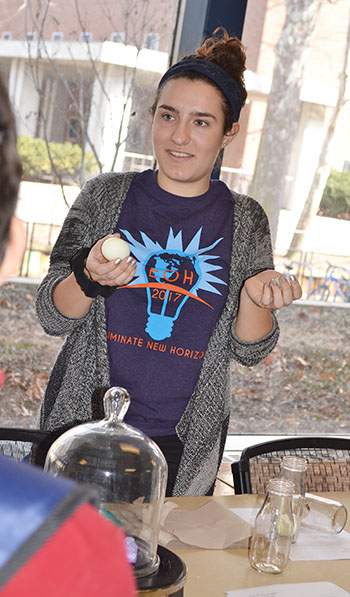
llinois physics student Hannah Manetsch prepares to use physics to get the egg in the bottle.
"The important thing is to be exposed to all this stuff,” he adds. “They're really lucky that they get to be exposed to this kind of stuff."
Another Illinois student, Hannah Manetsch, a sophomore in physics, and a member of the Society for Women in Physics, helped with the group’s “Food for Thought” exhibit, which included such fun activities such as egg in a bottle, and the electric pickle. She shares why she did EOH.
“I think it is an amazing time to be able to share our love for science with the community and with the people who come. Science is such an important part of life and even for those who don't use science every day, it is the reason why the universe exists. So I think it's just a really cool way to share that and get people interested in what science is—and I love physics—so what physics means for how you live.”
Had Maneetsch seen any young, budding physicists at EOH? She was hopeful that maybe some at least got interested in science. “Hopefully, they'll be interested and decide to think through more of ‘Why did that happen? That's so cool!’ and want to go do their own research and get interested in science at least.”
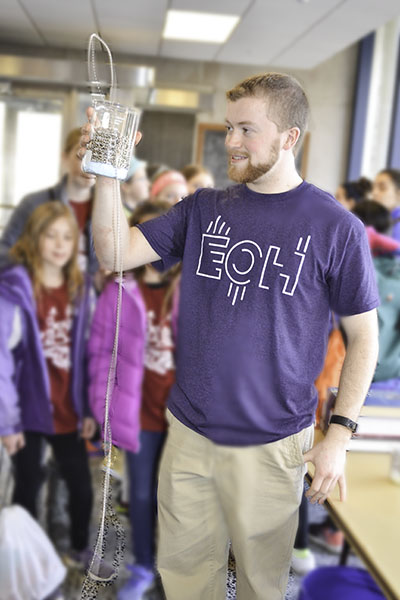
Austin Steinforth, Electrical Engineering Ph.D. student, who says he has been presenting his self-siphoning beads demo at EOH for the last several years.
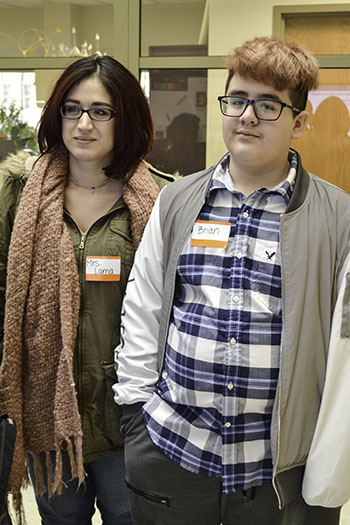
Tania Lama and her son, who visited EOH as part of a school field trip.
Another student, Austin Steinforth, who did his undergrad at Illinois in physics, and now is researching laser physics as he seeks a PhD in Electrical Engineering, shares why he got involved in Engineering Open House.
“I do EOH for the kids really. Kids absolutely love my demo. This is my fourth year straight, doing the exact same demo. It has nothing to do with my research, he admits, but I still love it, and I'll continue doing this for the next few years.”
In his demo, “Self-Siphoning Beads,” a string of metal beads succumbed to gravity, as one would expect; however, they also exhibited a rather unexpected phenomenon: they developed an arc, caused by the chains still lying in the container as they “pushed upward” because they were connected.
Of course, the engineering students, knowing that one sure way to engage a youngster is through sweets; so numerous exhibits were somehow related to them. Members of the Society for Engineering Mechanics, lured visitors with a Chocolate 3D printer (it prints out chocolate), and an automatic S’more Machine.
Plus, many exhibits offering a taste of something—often flash frozen with liquid nitrogen. For instance, there were liquid-nitrogen frozen marshmallows and liquid-nitrogen-frozen dippin’ dots. In a refreshing departure from liquid nitrogen goodies, there was whipped cream— made on the spot by the participants themselves, who explored the chemical properties of cream and milk while vigorously shaking a container to produce whipped cream.
Another parent, Tania Lama, who was experiencing EOH along with her son as part of a field trip offered by the Urbana Middle School, explains why it’s beneficial to bring students to the event.
“I think it's a good way for them to learn and experiment and opens their eyes to what is available through the university,” she says. “It's a way for them to interact with all the stuff that you guys have going on."
Lama adds that EOH was also a chance for her son to be exposed to some things he wouldn’t necessarily experience at school.
"So far he has been enjoying all the experiments and all the things that are hands-on in the exhibits here. I do feel that this is opening his doors for learning more and for him to learn that there is more to what he is learning in middle school."
Story and photographs by Elizabeth Innes, Communications Specialist, I-STEM Education Initiative.
More: Engineering, Engineering Open House, K-12 Outreach, Open Houses/Fairs/ Expos, 2018
For aditional I-STEM articles about Engineering Open House, see:
- NGS Middle Schoolers Build Bridges, Experience Engineering During EOH Design Contest
- EOS Contest Exposes Local Kids to EOH, Engineering
- EOH Visitors Discover that Engineering is Fun, Exciting, and Can Change the World
- Students/Alumni Promote Engineering at Illinois During EOH 2016
- Engineering Open House 2015 Looks to the Future
- Engineering Students Enjoy Exposing Visitors to STEM During EOH 2014
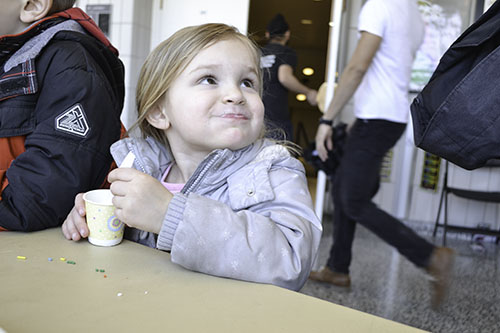
A young participant enjoys whipped cream...with sprinkles that she made.
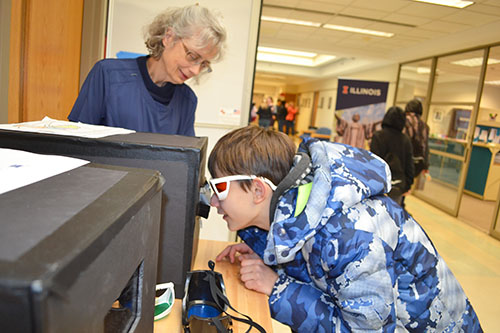
A young visitor experiences fluorescence at the MRL Open House.
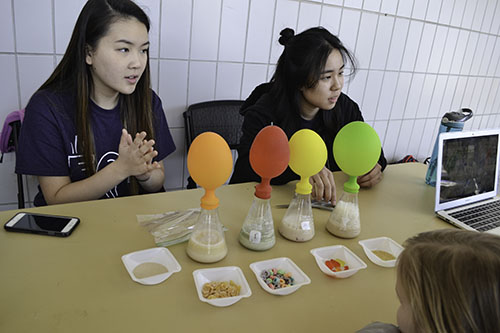
AIChE members demonstrate biofuels—how common sugar sources generate energy through chemical reaction.
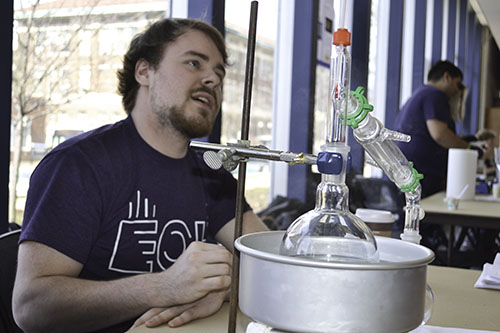 A Chemical Engineering student and member of OXE (Omega Chi Epsilon) mans an exhibit about distillation.
A Chemical Engineering student and member of OXE (Omega Chi Epsilon) mans an exhibit about distillation.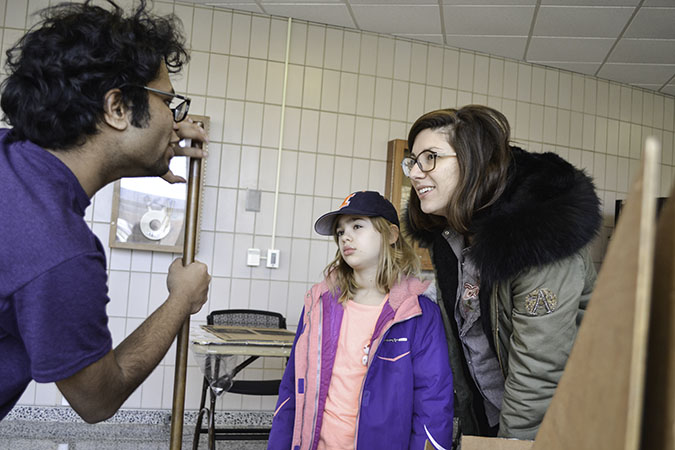
A mother and daughter learn some physics at EOH 2018.













.jpg)
















